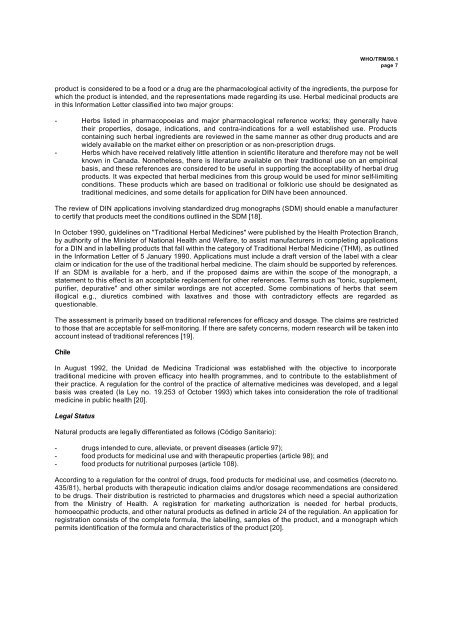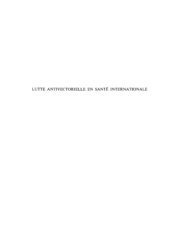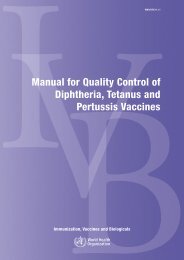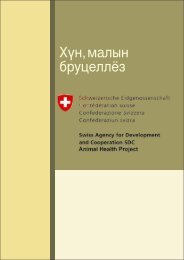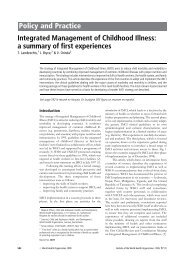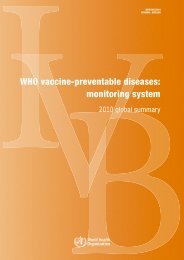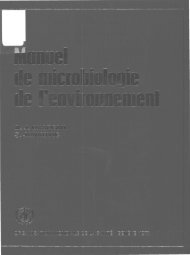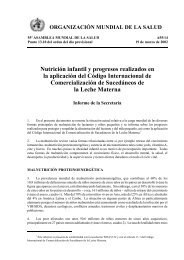WHO/TRM/98.1page 6- although herboristerias were controlled by law, the sale <strong>of</strong> medicinal plants through other distributionchannels was completely uncontrolled, which might be <strong>of</strong> critical importance where potentially toxicplants are sold;- although pharmacognostic methods are described in the Pharmacopea Nacional Argentina, nomethods for the determination <strong>of</strong> active principles, e.g., quantitative assay, were indicated;- there was no <strong>of</strong>ficial definition <strong>of</strong> what is a medicinal plant and what is not, some plants being usedas food although they were included in the pharmacopoeia; and- with respect to the Law No. 16.463, it was not clear which requirements had to be fulfilled to apply forregistration <strong>of</strong> a new medicine based on medicinal plants.Although scientific knowledge on medicinal and toxic plants was growing, it was necessary to gain moreinformation about the utilization <strong>of</strong> 700-800 species. There was no academic specialization for the control andthe processing <strong>of</strong> medicinal plants [15].For these reasons, the need for future legislation to remedy the unsatisfactory situation relating to medicinalplants became evident [15].In November 1993, a regulation for registration and commercialization <strong>of</strong> medicinal plants was published bythe Health Ministry <strong>of</strong> the Provincia de Buenos Aires. With this regulation, an obligation for the registration <strong>of</strong>medicinal herbs was established. The herboristerias had to register their products within 180 days, togetherwith documentation containing e.g., name <strong>of</strong> the plant, part <strong>of</strong> the plant, active principles, identification, andindications. In the case <strong>of</strong> a mixture <strong>of</strong> herbs, the benefit <strong>of</strong> the combination had to be demonstrated. Thecertificate issued by the Laboratorio Central de Salud is valid for five years, and a prolongation must be appliedfor 30 days before expiry [16].The Pharmacopea Nacional ArgentinaWithin the Pharmacopea Nacional Argentina, there are three categories <strong>of</strong> plants and their preparations: crudedrugs; extracts or fractions with a complex chemical composition extracted directly from a medicinal plant, e.g.,fixed or essential oils or resins; and pure active principles. The total number <strong>of</strong> such monographs is 899. Themonographs do not consider pharmaceutical preparations such as extracts, tinctures, aromatic waters etc. Ofthe 899 monographs, 56 describe crude drugs, and 33 describe extracts or fractions [15].Canada<strong>Herbal</strong> medicines are regulated as drugs in Canada and must therefore conform to labelling and otherrequirements as set out in the Food and Drugs Act and Regulations, which means that, in contrast to the USA,large numbers <strong>of</strong> herbal medicines with indication claims are legally on the Canadian market. Prior toassignment <strong>of</strong> a registration or drug identification number, scrutiny <strong>of</strong> the composition and the labelling <strong>of</strong>medicine is required.On 13 August 1987, following a long discussion between interested parties and experts, an Information Letterwas issued by the Canadian Health Protection Branch containing a list <strong>of</strong> herbs considered hazardous orrequiring cautionary labelling. It was reported that products may be sold as foods, drugs or even cosmeticsdepending on their properties, claims and the manner in which they are used. At that time, herbs andbotanicals were acceptable as drugs on the basis <strong>of</strong> acknowledged claims and quantitative statements <strong>of</strong> theactive ingredient. As a general practice, herbal remedies used for minor self-limiting conditions may beallocated Drug Identification Numbers (DIN), based on a logical pharmacological rationale and bibliographicreferences which include verified traditional uses that have not been superseded by more recent research andstudy. Furthermore, the need to provide a specific framework for the registration <strong>of</strong> herbs and botanicalpreparations has been identified, and a concept <strong>of</strong> review involving "Standardized Drug Monographs (SDM)"has been proposed to facilitate registration <strong>of</strong> those drugs containing herbs that meet the requirements <strong>of</strong> themonographs. Products making reference to such an SDM would require less individual pre-market scrutiny ona product-by-product basis and would result in more rapid issuance <strong>of</strong> DIN, but would be balanced withadditional post-market compliance monitoring and activity. Combinations <strong>of</strong> herbs outlined in suchmonographs would be accepted if justified on sound therapeutic principles. Claims in respect <strong>of</strong> prevention ortreatment <strong>of</strong> serious diseases and those which are inappropriate for self-diagnosis and treatment areprohibited within this procedure [17].On 5 January 1990, another Information Letter was issued to clarify the policy <strong>of</strong> the Health Protection Branchon herbal medicines, to outline the regulatory requirements, and to advise on the mechanisms for applicationsfor DIN for these products. It was clearly stated that the most important factors in determining whether a herbal
WHO/TRM/98.1page 7product is considered to be a food or a drug are the pharmacological activity <strong>of</strong> the ingredients, the purpose forwhich the product is intended, and the representations made regarding its use. <strong>Herbal</strong> medicinal products arein this Information Letter classified into two major groups:- Herbs listed in pharmacopoeias and major pharmacological reference works; they generally havetheir properties, dosage, indications, and contra-indications for a well established use. Productscontaining such herbal ingredients are reviewed in the same manner as other drug products and arewidely available on the market either on prescription or as non-prescription drugs.- Herbs which have received relatively little attention in scientific literature and therefore may not be wellknown in Canada. Nonetheless, there is literature available on their traditional use on an empiricalbasis, and these references are considered to be useful in supporting the acceptability <strong>of</strong> herbal drugproducts. It was expected that herbal medicines from this group would be used for minor self-limitingconditions. These products which are based on traditional or folkloric use should be designated astraditional medicines, and some details for application for DIN have been announced.The review <strong>of</strong> DIN applications involving standardized drug monographs (SDM) should enable a manufacturerto certify that products meet the conditions outlined in the SDM [18].In October 1990, guidelines on "Traditional <strong>Herbal</strong> <strong>Medicines</strong>" were published by the Health Protection Branch,by authority <strong>of</strong> the Minister <strong>of</strong> National Health and Welfare, to assist manufacturers in completing applicationsfor a DIN and in labelling products that fall within the category <strong>of</strong> Traditional <strong>Herbal</strong> Medicine (THM), as outlinedin the Information Letter <strong>of</strong> 5 January 1990. Applications must include a draft version <strong>of</strong> the label with a clearclaim or indication for the use <strong>of</strong> the traditional herbal medicine. The claim should be supported by references.If an SDM is available for a herb, and if the proposed claims are within the scope <strong>of</strong> the monograph, astatement to this effect is an acceptable replacement for other references. Terms such as "tonic, supplement,purifier, depurative" and other similar wordings are not accepted. Some combinations <strong>of</strong> herbs that seemillogical e.g., diuretics combined with laxatives and those with contradictory effects are regarded asquestionable.The assessment is primarily based on traditional references for efficacy and dosage. The claims are restrictedto those that are acceptable for self-monitoring. If there are safety concerns, modern research will be taken intoaccount instead <strong>of</strong> traditional references [19].ChileIn August 1992, the Unidad de Medicina Tradicional was established with the objective to incorporatetraditional medicine with proven efficacy into health programmes, and to contribute to the establishment <strong>of</strong>their practice. A regulation for the control <strong>of</strong> the practice <strong>of</strong> alternative medicines was developed, and a legalbasis was created (la Ley no. 19.253 <strong>of</strong> October 1993) which takes into consideration the role <strong>of</strong> traditionalmedicine in public health [20].Legal StatusNatural products are legally differentiated as follows (Código Sanitario):- drugs intended to cure, alleviate, or prevent diseases (article 97);- food products for medicinal use and with therapeutic properties (article 98); and- food products for nutritional purposes (article 108).According to a regulation for the control <strong>of</strong> drugs, food products for medicinal use, and cosmetics (decreto no.435/81), herbal products with therapeutic indication claims and/or dosage recommendations are consideredto be drugs. Their distribution is restricted to pharmacies and drugstores which need a special authorizationfrom the Ministry <strong>of</strong> Health. A registration for marketing authorization is needed for herbal products,homoeopathic products, and other natural products as defined in article 24 <strong>of</strong> the regulation. An application forregistration consists <strong>of</strong> the complete formula, the labelling, samples <strong>of</strong> the product, and a monograph whichpermits identification <strong>of</strong> the formula and characteristics <strong>of</strong> the product [20].


